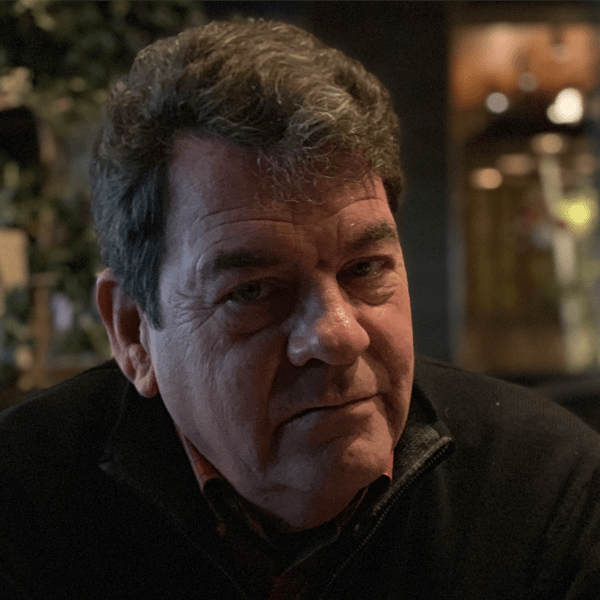
Michael Glancy discusses RISD’s early glass program and the department’s limited resources.
05:44Michael Glancy discusses RISD’s early glass program and the department’s limited resources. Oral history interview with Michael Glancy by Barb Elam, conducted via telephone, October 9, 2018, Bard Graduate Center. Clip length: 05:54.
Time stamp: 00:00
Clip 1: Michael Glancy discusses buying a used sandblaster for RISD. Clip length: 01:45.
Michael Glancy: Sandblasting, that’s a carving of the glass with a sandblaster. I encountered that in 1977, right after being married. I went to Pilchuck [Pilchuck Glass School, Stanwood, Washington], and enrolled in a Dan Dailey course, and with that—that’s the first time I saw sandblasting. We didn’t have a sandblaster at the Rhode Island School of Design. And so after that summer, I said to Dale Chihuly, ‘We need a sandblaster.’ He said, ‘No, I don’t have the budget for a sandblaster.’ He was more interested in the hot glass stuff. And so I went out and found and issued grant money—you know, applied to grants, got enough money to buy a sandblaster. It was used, but it was a sandblaster. We found it in a machine place in Boston, and the school—so I got the money, I got the machine. The school wouldn’t pay to have it transported, so I had to rent a truck with an Australian friend. We took the sand machine apart. Took it—put it on the truck, took it to the School of Design. We had a room for it but had to take the doors off the elevator to get the pieces in, take it up to the fourth floor, put the doors back on the elevator, push it down the hall, and put it in a room, and then the school took, I think, close to six months before they actually plumbed the sandblaster to the air compressor, which was four stories down. [laughs] But we did get one.
Time stamp: 01:48
Clip 2: Michael Glancy talks about RISD’s cold working shop being in the men’s bathroom. Clip length: 00:18.
Michael Glancy: And I mean, Dale [Chihuly] had the cold working shop. He really didn’t care about the cold working. He was only interested in hot glass. He had the cold working shop in the men’s bathroom. And the women in the department—or the students—had to do their cold working in the men’s bathroom.
Time stamp: 02:09
Clip 3: Michael Glancy discusses the lack of space and materials budget at RISD. Clip length: 00:42.
Michael Glancy: The big problem with a school that’s over a hundred years old is space. And so there was no space for cold working at the time, and [laughs] now—it didn’t last that long. But for instance, another thing, the sandblaster needed the abrasive—it’s not sand, it’s an abrasive, aluminum oxide. And he didn’t have a budget for that, so we had to put a coin-operated—like a washing machine, you get 15 minutes for a quarter—[laughs]—to generate funds to buy the abrasive. I tell you. It was—it’s a jungle out there.
Time stamp: 02:54
Clip 4: Michael Glancy discusses why RISD invested in a heat recycling exchange system for their glass shop. Clip length: 02:49.
Michael Glancy: When I first arrived it was summertime. And I arrived with my wife, who is—still is, and was, very pretty, blonde—but I arrived with her, her younger sister, and their younger sister. So I had these three really good-looking ladies following me in, and for the first time that I went into the glass shop at Rhode Island School of Design as an incoming student, and Dale was in there—it was the summertime, and the furnaces were on. But he and Jamie were in there just sitting and measuring the temperature at the benches. And it was like, I don’t know, 90 degrees outside and 106 in the benches, which is incredibly cool. And the reason for that was because Dale had installed these massively gigantic fans behind the hood, behind the furnaces that would take all of the air in the studio itself and remove it in under 30 seconds. Now this pumps out not just the air of the studio, which was hot, but sucked out all of the air in the building. And when RISD did this aerial survey, infrared survey, they found that the glass shop was emitting as much heat as the asphalt—open-air asphalt facility that was making asphalt for making roads, which was an open-air blast furnace, basically. And so the school then invested a quarter of a million dollars, which would have been, you know, probably three-quarters of a million dollars today—in a heat recycling—in a heat exchange, much more efficient. That was right after Dale left and Richard Harned took over as head of the department, and he convinced—the school had done this survey, and they were debating the cost of the glass program, and it’s only because of Dale’s notoriety and the students that he produced, who became ambassadors to glass in the United States and around the world, that the school continues with one of the most expensive departments that, you know, energy-wise, but it’s funny how we get where we get to.